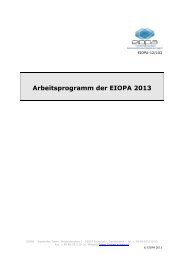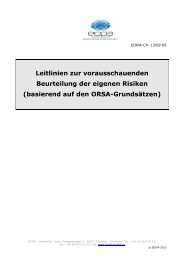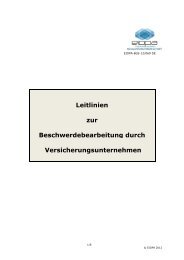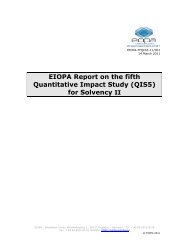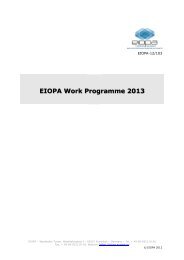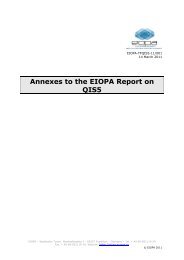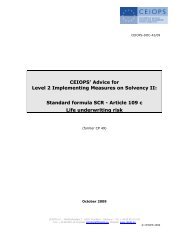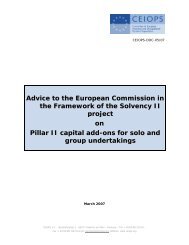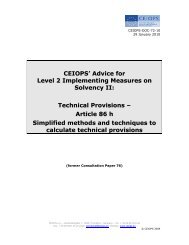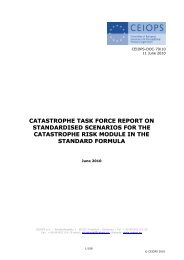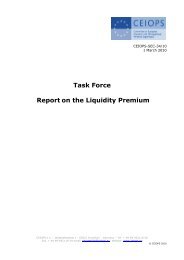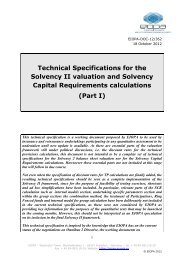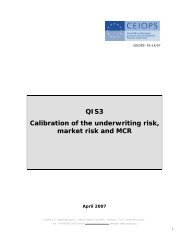Answers to the European Commission on the ... - Eiopa - Europa
Answers to the European Commission on the ... - Eiopa - Europa
Answers to the European Commission on the ... - Eiopa - Europa
Create successful ePaper yourself
Turn your PDF publications into a flip-book with our unique Google optimized e-Paper software.
levels and supervisory instruments and acti<strong>on</strong> is addressed in more<br />
detail in CEIOPS’ answer <str<strong>on</strong>g>to</str<strong>on</strong>g> CfA 15.<br />
18.15 The IGD requires <str<strong>on</strong>g>the</str<strong>on</strong>g> supplementary calculati<strong>on</strong> of <str<strong>on</strong>g>the</str<strong>on</strong>g> adjusted<br />
solvency of insurance undertakings in an insurance group. There are no<br />
analogous requirements at group level based <strong>on</strong> <str<strong>on</strong>g>the</str<strong>on</strong>g> currently required<br />
guarantee fund. The calculati<strong>on</strong> methods specified in <str<strong>on</strong>g>the</str<strong>on</strong>g> current IGD<br />
are in essence based <strong>on</strong> calculating <str<strong>on</strong>g>the</str<strong>on</strong>g> sums of <str<strong>on</strong>g>the</str<strong>on</strong>g> required and<br />
available solvency margins, adjusted for any multiple use of capital<br />
elements and inappropriate intra-group creati<strong>on</strong> of capital. The<br />
Financial C<strong>on</strong>glomerates Directive (FCD) 132 takes a similar approach <str<strong>on</strong>g>to</str<strong>on</strong>g><br />
solvency within a financial group c<strong>on</strong>text.<br />
18.16 CEIOPS notes that <str<strong>on</strong>g>the</str<strong>on</strong>g> calculati<strong>on</strong> methods described in <str<strong>on</strong>g>the</str<strong>on</strong>g> IGD are<br />
deemed equivalent. This noti<strong>on</strong> of equivalence may well be related <str<strong>on</strong>g>to</str<strong>on</strong>g><br />
<str<strong>on</strong>g>the</str<strong>on</strong>g> fairly simple way in which <str<strong>on</strong>g>the</str<strong>on</strong>g> present solvency requirements are<br />
determined: in essence a linear functi<strong>on</strong> of technical provisi<strong>on</strong>s, capital<br />
at risk, premiums and/or claims. If <str<strong>on</strong>g>the</str<strong>on</strong>g> c<strong>on</strong>solidated method is<br />
interpreted as being a fully integrated approach, <str<strong>on</strong>g>the</str<strong>on</strong>g> linear nature of<br />
<str<strong>on</strong>g>the</str<strong>on</strong>g> solo requirements would still imply an outcome which is equivalent<br />
<str<strong>on</strong>g>to</str<strong>on</strong>g> that of <str<strong>on</strong>g>the</str<strong>on</strong>g> o<str<strong>on</strong>g>the</str<strong>on</strong>g>r methods.<br />
18.17 Given <str<strong>on</strong>g>the</str<strong>on</strong>g> intended role of <str<strong>on</strong>g>the</str<strong>on</strong>g> MCR and SCR, CEIOPS advises that <str<strong>on</strong>g>the</str<strong>on</strong>g><br />
Framework Directive should include a SCR at group level. The<br />
<str<strong>on</strong>g>Commissi<strong>on</strong></str<strong>on</strong>g>’s Amended Framework for C<strong>on</strong>sultati<strong>on</strong> states that <str<strong>on</strong>g>the</str<strong>on</strong>g><br />
main focus of <str<strong>on</strong>g>the</str<strong>on</strong>g> Solvency II project is <strong>on</strong> capital requirements and<br />
supervisory review at <str<strong>on</strong>g>the</str<strong>on</strong>g> level of <str<strong>on</strong>g>the</str<strong>on</strong>g> individual legal entity. CEIOPS<br />
advises that within that c<strong>on</strong>text <str<strong>on</strong>g>the</str<strong>on</strong>g>re is no general need for <str<strong>on</strong>g>the</str<strong>on</strong>g><br />
impositi<strong>on</strong> of a MCR at group level; please note, however, <str<strong>on</strong>g>the</str<strong>on</strong>g> role of a<br />
group MCR as a ´floor´ <str<strong>on</strong>g>to</str<strong>on</strong>g> a group SCR discussed below.<br />
18.18 The Framework for C<strong>on</strong>sultati<strong>on</strong> expresses <str<strong>on</strong>g>the</str<strong>on</strong>g> philosophy that <str<strong>on</strong>g>the</str<strong>on</strong>g><br />
solvency requirements, and in particular <str<strong>on</strong>g>the</str<strong>on</strong>g> SCR, should properly<br />
reflect <str<strong>on</strong>g>the</str<strong>on</strong>g> risk profile of <str<strong>on</strong>g>the</str<strong>on</strong>g> insurer. The design and calibrati<strong>on</strong> of <str<strong>on</strong>g>the</str<strong>on</strong>g><br />
SCR will be based <strong>on</strong> <str<strong>on</strong>g>the</str<strong>on</strong>g> assumpti<strong>on</strong> of a diversified portfolio of both<br />
(insurance) liabilities and assets. CEIOPS recognises that where an<br />
insurer is part of a group, diversificati<strong>on</strong> benefits at group level may<br />
occur. At <str<strong>on</strong>g>the</str<strong>on</strong>g> same time, certain additi<strong>on</strong>al risks, such as direct<br />
c<strong>on</strong>tagi<strong>on</strong> risk or more indirect reputati<strong>on</strong> risk, may arise in a group<br />
c<strong>on</strong>text. CEIOPS also notes that risks that occur in a group c<strong>on</strong>text 133 ,<br />
such as reputati<strong>on</strong> risk, may be difficult <str<strong>on</strong>g>to</str<strong>on</strong>g> quantify. It is envisaged that<br />
<str<strong>on</strong>g>the</str<strong>on</strong>g> SCR may be determined via a standard formula, or through <str<strong>on</strong>g>the</str<strong>on</strong>g> use<br />
of a validated internal model.<br />
18.19 CEIOPS envisages that <str<strong>on</strong>g>the</str<strong>on</strong>g> SCR at solo level will be determined as a<br />
functi<strong>on</strong> of a number of risk fac<str<strong>on</strong>g>to</str<strong>on</strong>g>rs. It is foreseeable that this functi<strong>on</strong>,<br />
which aggregates <str<strong>on</strong>g>the</str<strong>on</strong>g> capital charges for <str<strong>on</strong>g>the</str<strong>on</strong>g> distinct risk fac<str<strong>on</strong>g>to</str<strong>on</strong>g>rs at solo<br />
level, will not be of a fully linear nature. This approach would have a<br />
number of implicati<strong>on</strong>s for <str<strong>on</strong>g>the</str<strong>on</strong>g> determinati<strong>on</strong> of SCR at group level.<br />
Most notably, <str<strong>on</strong>g>the</str<strong>on</strong>g> order and way in which risk fac<str<strong>on</strong>g>to</str<strong>on</strong>g>rs are aggregated<br />
132 Directive 2002/87/EC.<br />
133<br />
Please see <str<strong>on</strong>g>the</str<strong>on</strong>g> parts relating <str<strong>on</strong>g>to</str<strong>on</strong>g> insurance groups in Freshfields Bruckhaus Derringer, Study <strong>on</strong> financial<br />
c<strong>on</strong>glomerates and legal firewalls, 2003.<br />
206



